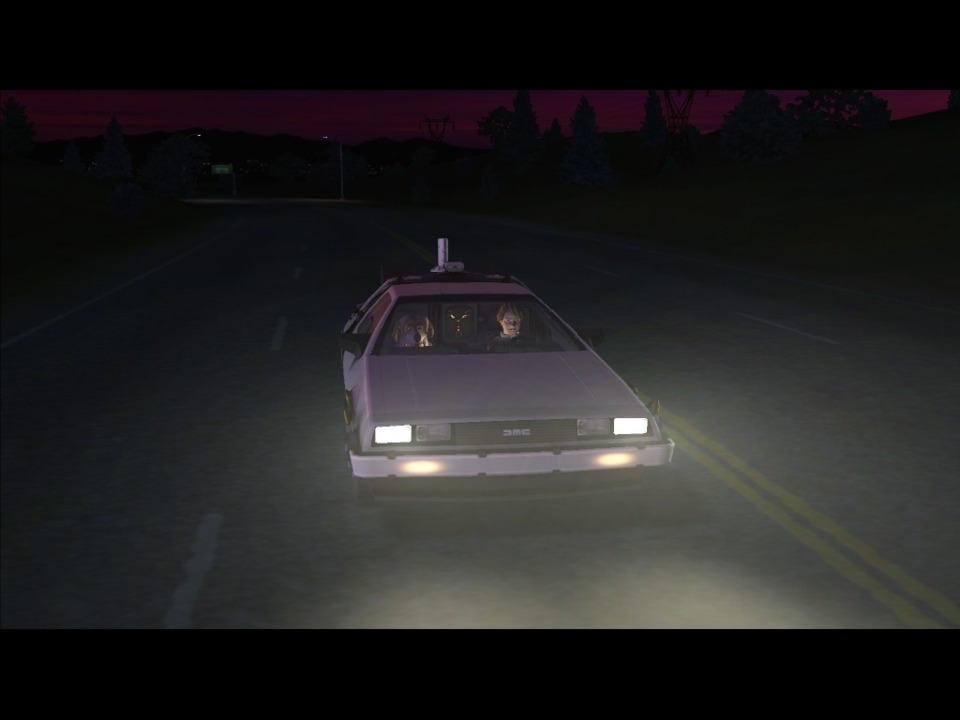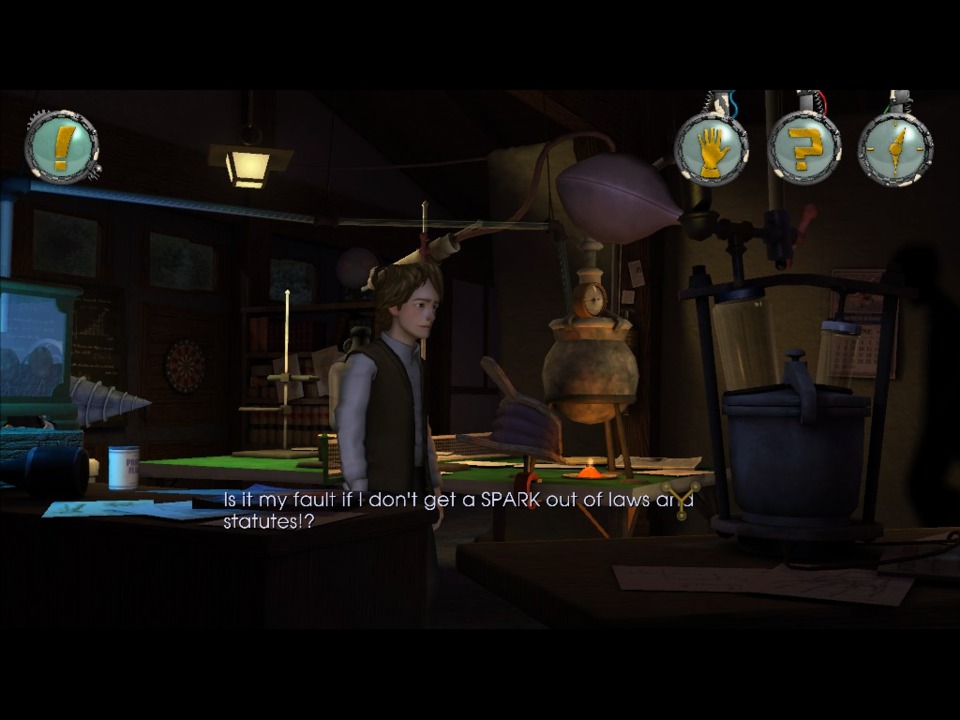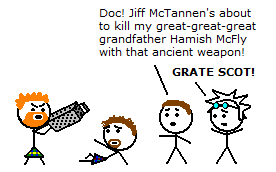The Comic Commish: Back to the Future: The Game
By Mento 4 Comments
Well, I'm nothing if not predictable. I meant to put this up earlier in the week, obviously, but I've been getting a little distracted with my Yakuza 3 playthrough. I'll have more to discuss with that open-world brawler once I've gotten a little further into it, but suffice it to say it's some Yakuza-ass Yakuza but far prettier. Also I guess Kazama Kiryu has a blog now? I dunno, man, bloggers are kind of the worst.
But enough of that; we're not here to talk about the future. We're here to talk about the BTTF game from Telltale Games. I remember these scrappy licensed adventure game developers back when they were securing the rights to make new games based on Secret of Monkey Island, Sam & Max and Strong Bad (and the rest of the Homestar Runner menagerie). Though occasionally scorned for their lackluster puzzle design and production values, even back then Telltale was well regarded when it came to the fidelity of its various source materials. That attention to detail has kept them going strong to this day, though they seem to have switched tracks from mediocre point-and-click puzzles to "choose your own adventure" binary decisions based on moral quandaries.
As you might surmise from my tone, I wasn't invested enough to pursue Telltale's acclaimed The Walking Dead (I've never been particularly fascinated by zombie survival fiction, though I do know the original artist of The Walking Dead comic from way back in the day - I actually narrowly missed the chance to appear as a zombie in one of the earliest issues. Weird story) and I've yet to try any of their subsequent projects because I've heard that they don't really carry themselves as adventure games first and foremost, relying more on TWD's cutscene- and QTE-driven model since it did so well for them. Maybe I've been a little unfair, though. Even though I adored the Strong Bad series - mostly for all the Homestar references - none of the other Telltale games I've dabbled into have grabbed me as of yet... but then I've not been giving them much of a chance to, either.
So while I may have picked BTTF to cover this month out of some surprisingly overt SEO-baity reasons (even for me) I am also a little curious about TT's treatment of one of my favorite movie franchises. My thanks go to non-GB internet buddy Rolling_Go for the hook up.
Back to the Future: The Game: Episode 1: It's About Time
As with last month's look at S.T.A.L.K.E.R.: Shadow of Chernobyl, I'm going to be using screenshots sparingly because I don't intend to get super spoiler-heavy with this story-driven game despite it being some four or five years old. I'm also only covering the first chapter of five here, so I don't imagine I'll reveal too much of what this episodic series has to offer regardless. What I'm sure it does offer are precedents, and I don't think it'd be unfair of me to assume the rest of its episodes follow in the spirit of the first in terms of mechanical features and general presentation at the very least. Yes, the plotting might improve (or fall apart, conversely), but I imagine certain other aspects are with us for the long haul. It's not like they're going to completely rehaul the game's cartoonish art style midway through, for example.
Back to the Future: The Game starts about a year after the conclusion of the third movie. Doc Brown's house is being foreclosed, since he chose to vanish with his family on his time-travel train rather than return to the present and pay his goddamn bills. Well, the "present" of 1985-86. Though the game doesn't spend very long in its 1986 setting, there's enough minor attention to detail spent on the period to satisfy anachronism pedants. Middle-aged Biff Tannen's still in his ugly tracksuit, a VHS rental store still factors into the early few puzzles and Marty doesn't randomly whip out a mobile to tell Jennifer he'll be out doing time-travel shit for the foreseeable past/future. Another little attention to detail I loved early on can be seen in this screenshot:
So already, Back to the Future starts strong. A few cute references can be found with Marty, his father George and their everpresent though mostly defanged nemesis Biff at Doc's place. Biff will obnoxiously take over the jukebox if you go near it, playing Huey Lewis and the News' movie tie-in track "Back in Time". Marty's giant amp-blowing guitar performance from the start of the very first movie also factors into a puzzle to recover Doc's notebook. The movie references continue on in this fashion for almost the entire episode, even when it eventually gets its ass to the heretofore unexplored Hill Valley of the 1930s to follow the game's storyline, but there aren't so many to be jarring. They're more sneaky allusions to events of the movies than straight up pointed references: like how when passing an Arcade, Marty wonders if the Wild Gunman machine has been fixed yet.
As for a brief story synopsis, ol' Doc Brown has gotten himself arrested as the mysterious speakeasy arsonist "Carl Sagan" - stealing some of Marty's unimaginative alias thunder - in the 1930s. The Delorean, miraculously returned to being because how could you have a BTTF game without the Delorean in it, is automatically returned to the parking space behind Doc's house as part of a contingency measure, carrying with it a cassette tape plea to Marty and, inexplicably, his dog Einstein. The game raises a few questions early on which I hope later chapters will address, though Marty doesn't seem to bring either of them up for the moment: what happened to Clara and Doc Brown's creepy kids, and why does he have a Delorean again? The BTTF movies are always extremely careful to pave over its time-travel related plotholes, so I hope some explanations are forthcoming. The old Mystery Science 3000 mantra of "it's just a movie, or a game based on a movie in this case" wouldn't really be true to its meticulous spirit.

As far as the puzzle design is concerned, BTTF is merely adequate. It doubles up on an instance where Einstein picks up the scent of an NPC based on an item of clothing (is that a sheepdog thing? I thought their deal was herding dumb animals) and another where you record a piece of NPC dialogue on the cassette tapedeck that carried Doc's panicked plea for help and play it for a different NPC to trick them. Given that there's about five big puzzle sequences in total for "It's About Time", it seems a bit cheap to be reusing solutions in the same episode: I shudder to think how many more times I'll be relying on Einstein's nose or this Walkman before all five episodes are through. I suppose they're easier to work puzzles around than a hoverboard. The game also has an annoying tendency to create puzzles that cannot be solved until you've "given up" for the time being and found that a different screen has changed - an example of this involves finding out where Marty McFly's pusillanimous grandfather Artie is hiding (his gangster boss, who is naturally yet another Tannen, is keeping him out of sight to avoid the cops and their pressing questions), but then being unable to convince him to come down from the hideout so he can be served a subpoena to continue the story. After trying a few of the stock conversation options to no avail, it turns out you need to return to Hill Valley's town square to discover that some vital NPCs have magically appeared and you can complete the puzzle. There's never enough moving parts in any given episode of a Telltale game to thoroughly frustrate players with roadblocks, but cases like the above are still irritating.
I'll say for fairness's sake that there are some novel puzzles as well. One sequence has you manipulating a dim goon, a barricaded door, a pipe system and the surreptitious elevator to a speakeasy hidden under a soup kitchen to transport a barrel of moonshine to where you need it, but I came upon the solution almost entirely accidentally. Another involves listening to a tirade between the recently befriended teenage Emmet Brown of the 1930s and his intimidating (but unseen) judge father that emphasizes certain words that are integral to a scientific distillation process that Marty is forced to perform while Emmet's keeping his father distracted: whenever Emmet talks about how HEATED his father is becoming, for instance, it means that Marty needs to increase the temperature of the scientific apparatus. This sequence increases in speed and difficulty as it goes on, eventually also including similarly weighted words from Judge Brown that, of course, have no relevance to what you should be doing to complete the process. A little goofy, but fairly well thought-out comparative to the rest of the episode. It's the infrequent instances like those that stop me from writing off the puzzles of "It's About Time" completely. But hey, I'm mostly here for more BTTF shenanigans. I gotta believe that it also occurred to Telltale eventually that the stories and the settings were more important than attempting to come up with smart headscratchers to bamboozle players, which might explain The Walking Dead's lighter touch with inventory puzzles.

Overall, I quite liked the first episode of Back to the Future: The Game. It's a little rough in spots, but it helps that I have a lot of affection for the franchise it's based on and the gameplay's not so bad to put me off wanting to find out what happens next. It's a similar reaction I had to that Ghostbusters: The Video Game that came out a little while ago: I wasn't wild about its generic third-person shooter gameplay, but I appreciated the level of attention and respect it gave its decades-old source material and how it found a way to extend the movie's story that didn't feel like some entirely disposable, non-canonical video game hokum. That Ghostbusters game genuinely felt like a continuation of the mythology established by the initial movie - more so than Ghostbusters 2, for as much as I tend to think that movie is unfairly maligned. Maybe once I've reached the end of this BTTF series I'll feel the same way about it.
That's all I've got to say about Back to the Future: The Game so far, but I can't rightly sign off on a Comic Commish without one of these:

